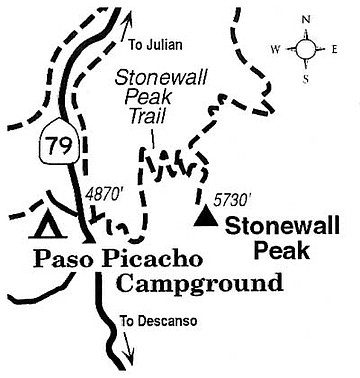 Facebook
Facebook
 X
X
 Instagram
Instagram
 TikTok
TikTok
 Youtube
Youtube
Stonewall Peak's angular summit of white granitic rock is a conspicuous landmark throughout Cuyamaca Rancho State Park. Although Stonewall stands some 800 feet lower than nearby Cuyamaca Peak, its central position and steep, south slope provide a more inclusive view of the park area itself.
Beginning across the highway from the entrance to Paso Picacho Campground (on Highway 79 about midway between Julian and Descanso), the 2.2-mile-long trail to Stonewall's top climbs steadily and moderately on a set of well-graded switchbacks. The former live-oak/black-oak forest and scattered pines and cedars that grew on the mountain's lower slopes prior to the 2003 Cedar Fire are mostly gone now. Pioneering shrubbery is making a comeback, but there's not yet enough of it to seriously block the view -- which expands incrementally the higher you go.
About halfway up the trail, a view opens to the north and east. Cuyamaca Reservoir lies to the north, its level and its extent varying according to the season and the year's precipitation. During the wettest years, the water surface floods a spacious meadow just above the main reservoir and covers a total of nearly 1000 acres.
When you reach the top of the switchback segments, turn right (south) toward the summit of the peak. Follow the trail as it knifes upward to the ridge top and farther to the base of the Stonewall's naked granite summit. A series of steps hewn in the rock and a guardrail are provided in the last, very steep hundred feet or so. The Stonewall hike is a great one for kids, but very small ones must be carefully guarded on the final climb up the steps.
On top, you won't see any ocean views (the main Cuyamaca Mountains ridgeline stands tall in the west), but the foreground panorama of the park's rolling topography is impressive enough. Late-season precipitation (the peak was dusted with snow as late as April 5) will ensure that the landscape below remains emerald-green for a few more weeks to come.
During spring and summer, swallows or swifts practically rake the summit during their high-speed maneuvers, and larger birds -- ravens, hawks, and even bald eagles -- may cruise by. Eagles, along with egrets, herons, and ospreys, are attracted to the shoreline of nearby Cuyamaca Reservoir, especially in winter.
This article contains information about a publicly owned recreation or wilderness area. Trails and pathways are not necessarily marked. Conditions can change rapidly. Hikers should be properly equipped and have safety and navigational skills. The Reader and Jerry Schad assume no responsibility for any adverse experience.


Stonewall Peak's angular summit of white granitic rock is a conspicuous landmark throughout Cuyamaca Rancho State Park. Although Stonewall stands some 800 feet lower than nearby Cuyamaca Peak, its central position and steep, south slope provide a more inclusive view of the park area itself.
Beginning across the highway from the entrance to Paso Picacho Campground (on Highway 79 about midway between Julian and Descanso), the 2.2-mile-long trail to Stonewall's top climbs steadily and moderately on a set of well-graded switchbacks. The former live-oak/black-oak forest and scattered pines and cedars that grew on the mountain's lower slopes prior to the 2003 Cedar Fire are mostly gone now. Pioneering shrubbery is making a comeback, but there's not yet enough of it to seriously block the view -- which expands incrementally the higher you go.
About halfway up the trail, a view opens to the north and east. Cuyamaca Reservoir lies to the north, its level and its extent varying according to the season and the year's precipitation. During the wettest years, the water surface floods a spacious meadow just above the main reservoir and covers a total of nearly 1000 acres.
When you reach the top of the switchback segments, turn right (south) toward the summit of the peak. Follow the trail as it knifes upward to the ridge top and farther to the base of the Stonewall's naked granite summit. A series of steps hewn in the rock and a guardrail are provided in the last, very steep hundred feet or so. The Stonewall hike is a great one for kids, but very small ones must be carefully guarded on the final climb up the steps.
On top, you won't see any ocean views (the main Cuyamaca Mountains ridgeline stands tall in the west), but the foreground panorama of the park's rolling topography is impressive enough. Late-season precipitation (the peak was dusted with snow as late as April 5) will ensure that the landscape below remains emerald-green for a few more weeks to come.
During spring and summer, swallows or swifts practically rake the summit during their high-speed maneuvers, and larger birds -- ravens, hawks, and even bald eagles -- may cruise by. Eagles, along with egrets, herons, and ospreys, are attracted to the shoreline of nearby Cuyamaca Reservoir, especially in winter.
This article contains information about a publicly owned recreation or wilderness area. Trails and pathways are not necessarily marked. Conditions can change rapidly. Hikers should be properly equipped and have safety and navigational skills. The Reader and Jerry Schad assume no responsibility for any adverse experience.
